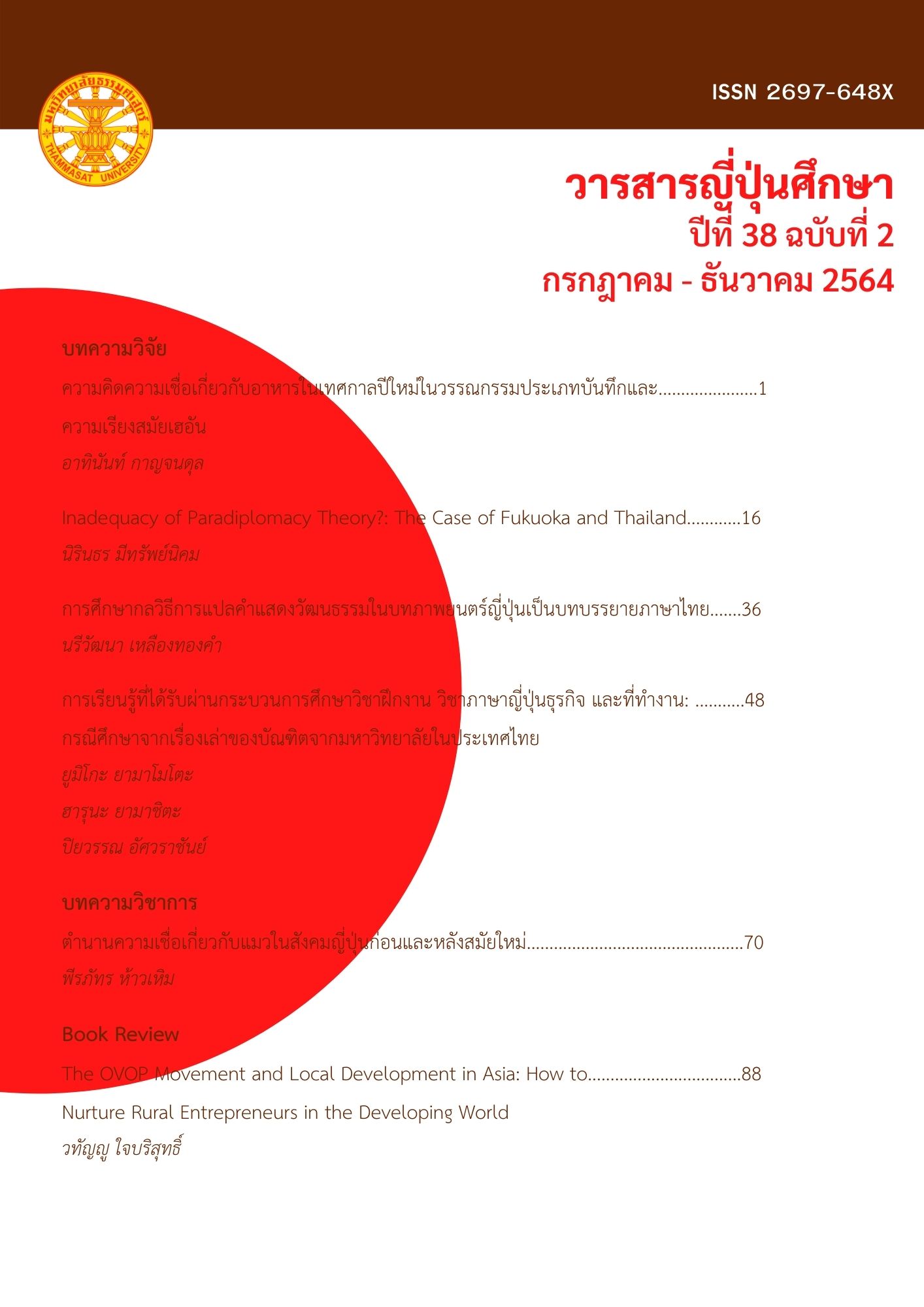ตำนานความเชื่อเกี่ยวกับแมวในสังคมญี่ปุ่นก่อนและหลังสมัยใหม่
คำสำคัญ:
ตำนาน, ความเชื่อ, แมว, สังคมญี่ปุ่น, เอโดะตอนปลายต่อสมัยเมจิตอนต้นบทคัดย่อ
บทความฉบับนี้มีวัตถุประสงค์ดังนี้ 1) เพื่อศึกษาตำนานความเชื่อของสังคมญี่ปุ่นก่อนสมัยใหม่ที่มีต่อแมว 2) เพื่อศึกษาเรื่องราวของแมวญี่ปุ่นที่ถูกนำมาผลิตซ้ำในสังคมญี่ปุ่นหลังสมัยใหม่ ผลการศึกษาพบว่า ประเด็นที่ 1) สังคมญี่ปุ่นมีความผูกพันกับแมวในฐานะสัตว์เลี้ยงมาอย่างน้อยตั้งแต่สมัยเฮอัน ซึ่งปรากฏหลักฐานในวรรณกรรมเก่าแก่ ประเด็นที่ 2) แง่มุมทางคติชนวิทยาสะท้อนให้เห็นว่าสังคมญี่ปุ่นก่อนสมัยใหม่ผูกติดกับแมวในฐานะสิ่งศักดิ์สิทธิ์ที่ให้ทั้งความโชคดี และความโชคร้าย โครงเรื่องเกี่ยวกับแมวและเรื่องราวเหนือธรรมชาติจึงถูกผูกเชื่อมโยงและถูกนำมาผลิตซ้ำในฐานะของนิทาน ตำนาน รวมถึงความเชื่อต่าง ๆ ประเด็นที่ 3) ความเชื่อของแมวต่อสังคมญี่ปุ่นถูกนำมาผลิตเป็นเรื่องราวต่าง ๆ และถูกนำมาใช้ในเชิงพาณิชย์ซึ่งสะท้อนให้เห็นถึงอิทธิพลของความเชื่อต่าง ๆ ของสังคมญี่ปุ่นอย่างชัดเจนโดยเฉพาะ “แมวกวัก”
Downloads
เอกสารอ้างอิง
Alan, R. (2010). Lafcadio Hearn and Cats. 熊本大学教育学部紀要, 人文科学, 59, 189-198.
Casal, U. A. (1959). The Goblin Fox and Badger and Other Witch Animals of Japan. Folklore Studies. 18, 1-93.
Daiyata, M. (2018). Rououchawa (Japanese Edition). Ame Shobo.
Davission, Z. (2021, June 09). Japan’s Love-Hate Relationship with Cats. https://www.smithsonianmag.com/arts-culture/japans-love-hate-relationship-with-cats-180975764/
Dykstra, Y. K. (1992). Notable Tales Old and New. Tachibana Narisue's Kokon Chomonju. Monumenta Nipponica, 47(4), 469-493.
Eiji, I. (2020). Wa Neko No Ashiato Tokyo No Neko Densetsu Wo Tadoru. Midori Shobo.
Fogle, B. (1997). Encyclopedia of the Cat. DK Publishing.
Harada, T. (1986). Nihon denki densetsu daijiten [日本伝奇伝説大事典]. Kadokawa Shoten.
Isao, T. (1999). Kuniyoshi-yokai-hyakkei [国芳妖怪百景]. Kokushokankokai.
Ishige, N. (1993). Shokutaku-no-bunkashi. [食卓の文化誌]. Iwanami Shoten.
Iwao, H. (2006). 動物妖怪譚. Chuokoron-Shinsha.
Japanese Folklore Research Center. (2021, June 09). Bakeneko And Their Tragic Creation. https://researcherposts.tumblr.com/post/189512749638/bake-neko-and-their-tragic-creation
Johansson, C. (2012). Origin of the Egyptian Domestic Cat. Uppsala University.
Kunio, Y. (1942). Japanese Folk Tales [日本の昔話]. Mikuni Shobo.
Kunio, Y. (1947). The Japanese Folk Tale. Indiana University Press.
Murakami, K. (2002). Yokai-wookaa [妖怪ウォーカー]. Kadokawa Shoten.
Murakami, K. (2008). Kai: Neko-no-kai [怪: 猫の怪]. Kadokawa Shoten.
Naogusa, Y. (1989). 宿直草. In 高田衛編 (ed.), 江戸怪談集. (pp. 121-124). Iwanami Shoten.
Negishi, Y. (2021 June 09). 化け猫. http://widetown.cocotte.jp/japan_den/japan_den178.htm#top
Opler, M. E. (1945). Japanese folk belief concerning the cat. Journal of the Washington Academy of Sciences,35(9), 269-275.
Picken, S. D. B. (1994). Essentials of Shinto an Analytical Guide to Principal Teaching. Greenwood Press.
Suzuki, T. (1982). Nihon-zokushin-jiten Dou,shokubutsu-hen [日本俗信辞典 動・植物編]. Kadokawa Shoten.
Tanigawa, T. (1998). 続 日本の地名. Iwanami Shoten.
Wikipedia. (2021, June 10). Bakemono no e. https://en.wikipedia.org/wiki/Bakemono_no_e
Wikipedia. (2021, June 09). Japanese Bobtail. https://ja.wikipedia.org/wiki/ジャパニーズボブテイル
Wright, A. F. (1960). The Study of Chinese Civilization. Journal of the History of Ideas, (2) 233-255.
佐野賢治他. (1980). 民間信仰辞典桜井徳太郎編 (ed.), Tokyodoshuppan.
松本 舞. (2018). 猫と文学 ― その壱(ヨーロッパ篇). 表現技術研究, 13, 1-21
ดาวน์โหลด
เผยแพร่แล้ว
ฉบับ
ประเภทบทความ
สัญญาอนุญาต
ลิขสิทธิ์ (c) 2021 วารสารญี่ปุ่นศึกษา

อนุญาตภายใต้เงื่อนไข Creative Commons Attribution-NonCommercial-NoDerivatives 4.0 International License.




